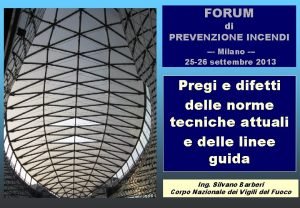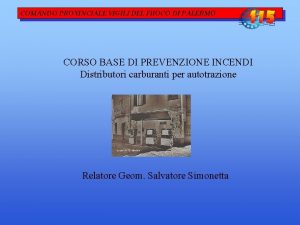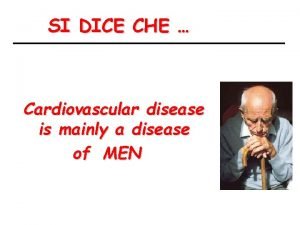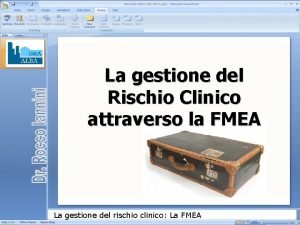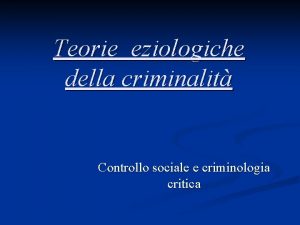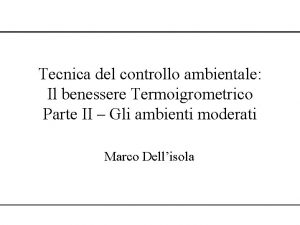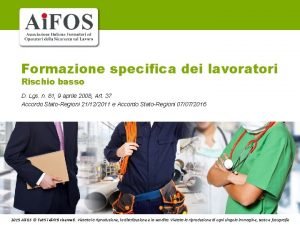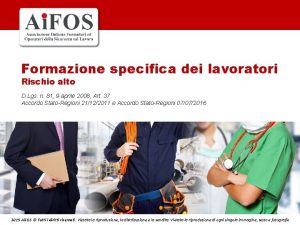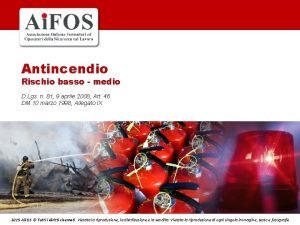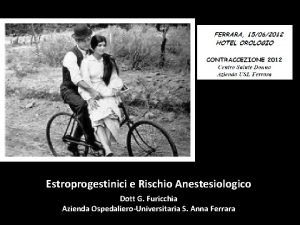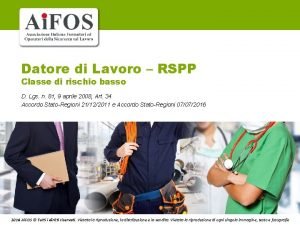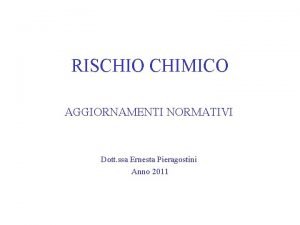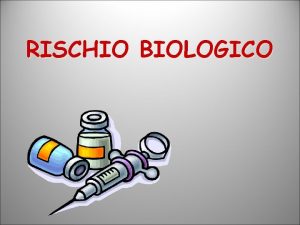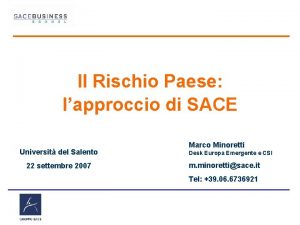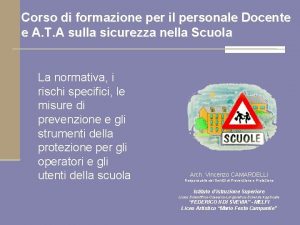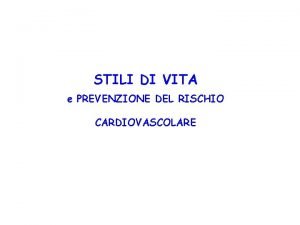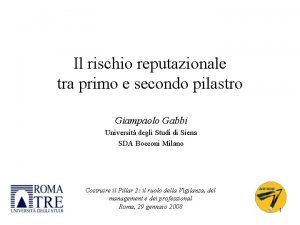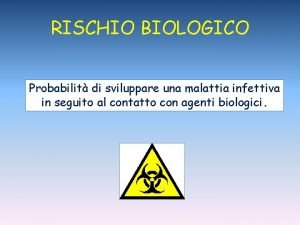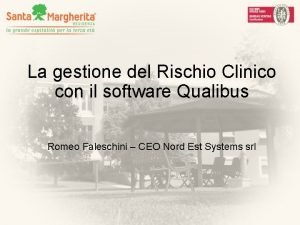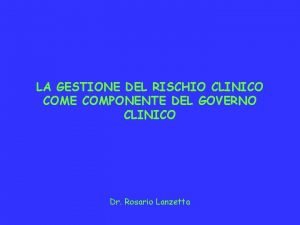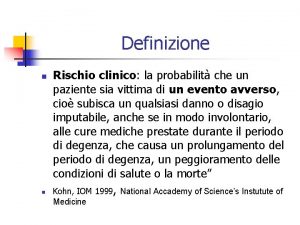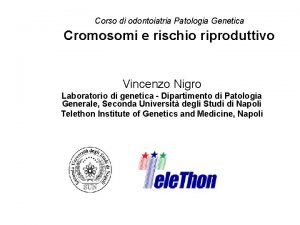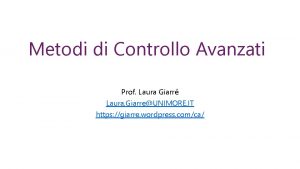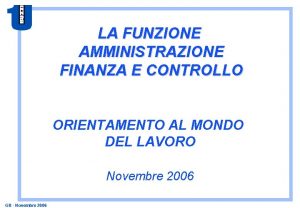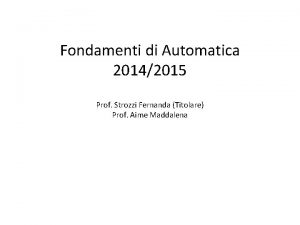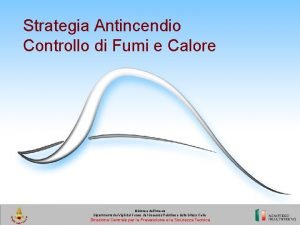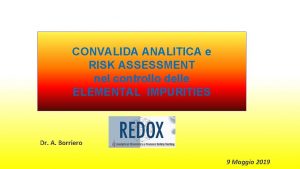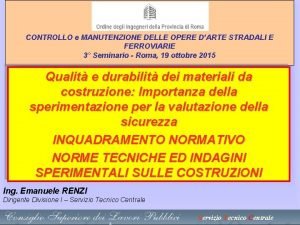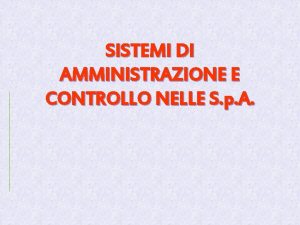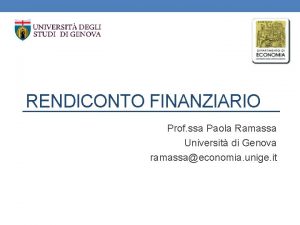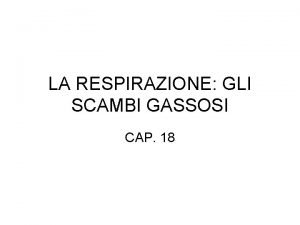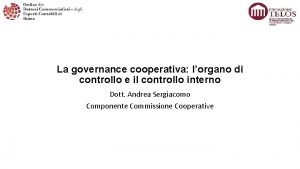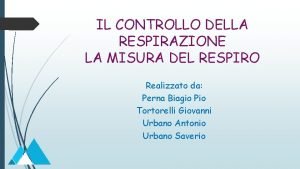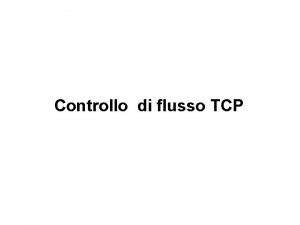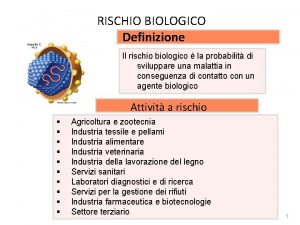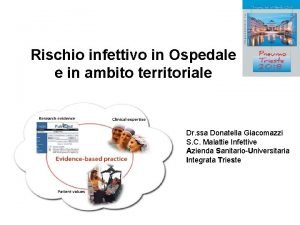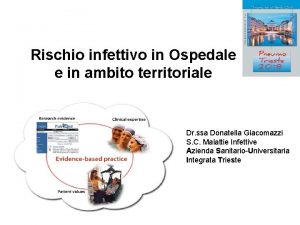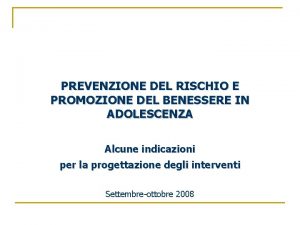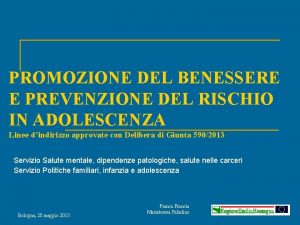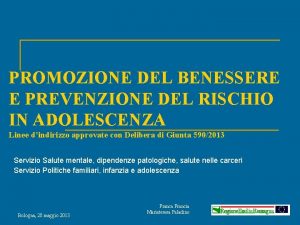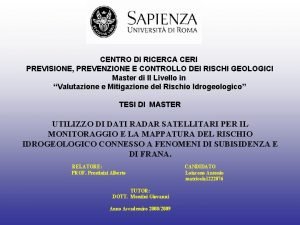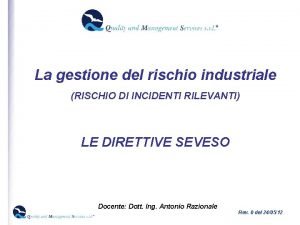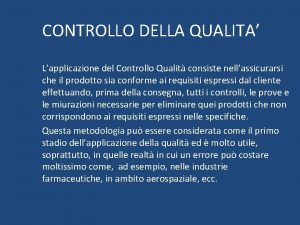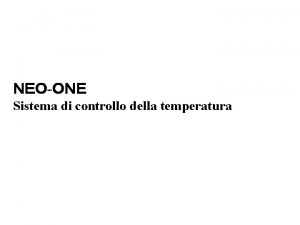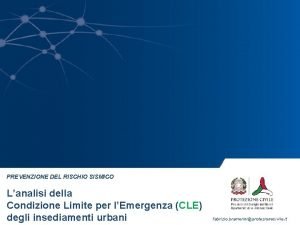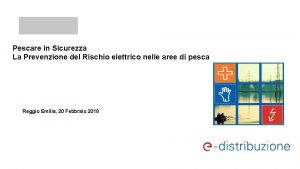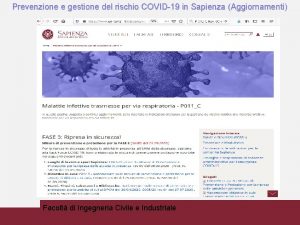CENTRO DI PREVENZIONE E CONTROLLO DEL RISCHIO INFETTIVO


















































- Slides: 50

CENTRO DI PREVENZIONE E CONTROLLO DEL RISCHIO INFETTIVO IN OSPEDALE U. O. C. DI MALATTIE INFETTIVE - OSPEDALE “FAZZI” – ASL. LECCE

Endocarditi Infettive L’ Endocardite infettiva è un’infezione microbica delle valvole cardiache o dell’endocardio che si sviluppa in corrispondenza di lesioni anatomiche congenite o acquisite

Endocarditi Infettive Incidenza 2 – 12 casi/100000/anno Uomini/Donne 1. 7 : 1. 0

Mortalità per Endocardite Infettiva Streptococcus Viridans 4 – 16 % S. Aureus 25 – 47 % Miceti 50 % > Valvola protesica > Pazienti immunodepressi > Per insufficienza cardiaca congestizia > ascessi > precedenti neurologici > Insufficienza renale

Fattori di rischio per E. I. Intervento odontoiatrico 21% Procedura chirurgica 6 %

Condizioni associate ad E. I. Diabete mellito Neoplasia Pregressa endocardite Febbre reumatica Intervento di CCH o Protesi valvolare I. R. in Emodialisi Infezione da HIV T. D. e. v. Età avanzata Cardiopatia congenita

E. I. : rischio nell’anziano (Studio Francese, 2004) • Incidenza 31 casi/milione di abitanti/anno • Massima incidenza tra 70 e 80 aa. • > 65 rischio > 8 volte rispetto < 65

E. I. : rischio nell’anziano > Patologie a carico dell’apparato gastrointestinale ed urinario > frequenza di P. M. > probabilità di coesistente anemia

E. I. e protesi valvolare Percentuale cumulativa di E. I. su P. V. • Ad 1 anno intervento 1. 5 – 3. 0 % • A 5 anni intervento 3 – 6 % • > rischio nei 6 mesi dopo impianto

E. I. e cardiopatia congenita • • • Incidenza dopo correzione chirurgica Tetralogia di Fallot 1. 3 % Difetto isolato del setto I. V. 2. 7 % Coartazione Aortica 3. 5 % Stenosi Aortica 13. 3 % Difetto isolato di setto I. A. 2. 8 %

Endocarditi Nosocomiali Si manifestano entro 48 ore dall’ospedalizzazione e sono associate ad una procedura medico-chirurgica.

Endocarditi nosocomiali su valvole native Sono il più delle volte la conseguenza di una batteriemia a partenza da cateteri endovascolari e meno frequentemente di infezioni chirurgiche o urinarie

E. I. : Etiologia Batteri Gram + 80 – 90% Streptococchi e Stafilococchi Batteri Gram – Anaerobi Miceti Etiologia polimicrobica Microrganismi intracellulari ed atipici Clamidie, Richettsie, Micoplasmi, miceti, virus

CENTRO DI PREVENZIONE E CONTROLLO DEL RISCHIO INFETTIVO IN OSPEDALE U. O. C. DI MALATTIE INFETTIVE - OSPEDALE “FAZZI” – ASL. LECCE

CENTRO DI PREVENZIONE E CONTROLLO DEL RISCHIO INFETTIVO IN OSPEDALE U. O. C. DI MALATTIE INFETTIVE - OSPEDALE “FAZZI” – ASL. LECCE Valvole native

CENTRO DI PREVENZIONE E CONTROLLO DEL RISCHIO INFETTIVO IN OSPEDALE U. O. C. DI MALATTIE INFETTIVE - OSPEDALE “FAZZI” – ASL. LECCE

Co. NS Health care associated native valve IE S. aureus Viridans Streptococci Symptoms > 1 month 26% 5. 3% 40% Surgical therapy 60% 33% 44% Stroke 12% 23% 12% CENTRO DI PREVENZIONE E CONTROLLO DEL RISCHIO INFETTIVO IN OSPEDALE U. O. C. DI MALATTIE INFETTIVE - OSPEDALE “FAZZI” – ASL. LECCE 1635 pts with definite native valve IE and no history of IVDU

E. I. : quadri clinici ed etiologia Procedura odontoiatrica Protesi valvolare < 2 m. Str. Viridans Protesi valvolare > 2 m S. spp. , S. Epidermidis, S. Aureus, Difteroidi, enterococco Infezioni vie urinarie Flebite da catetere Alcolismo Ca Colon T. D. e. v. Enterococco, Gram - S. Epidermidis, S. Aureus, gram-, enterococco. , miceti S. Aureus, S. Epidermidis, Candida, Gram. Pneumococco S. Bovis S. Aureus, Candida, Gram-

E. I. : meccanismi patogenetici • • • Adesione batterica alla valvola Caratteristiche dei microrganismi Persistenza dei batteri in situ Invasione tissutale e disseminazione Batteriemie transitorie Difese dell’ospite

E. I. : diagnosi • Ecocardigrammma transtoracico ( TTE ) • Ecocardiogramma transesofageo ( TEE )

E. I. : Reperti Eco. C. • • • Massa mobile ecodensa adesa all’endocardio valvolare o murale Presenza di ascessi o fistole Deiscenza di una protesi valvolare di nuova insorgenza specie se tardiva rispetto all’impianto

Ecocardio TTE Mezzo diagnostico non invasivo dotato di elevata specificità per le lesioni valvolari 98% Inadeguato in caso di : Obesità BPCO Deformazione della parete toracica

Ecocardio TEE Mezzo diagnostico costoso ed invasivo Sensibilità 75 – 95 % Specificità 85 – 98 % Rileva vegetazioni di mm 1. 0

E. I. diagnosi Eco. C. Trombi intracavitari non infetti Tumori endocardici Vegetazioni non infette Vegetazioni piccole o fisse Inesperienza dell’operatore

E. I. : diagnosi di laboratorio Emocolture Coltura della valvola Coltura di CVC Emocolture negative dal 3 al 23 %

Monoterapia o associazione Ruolo di Daptomicina Enterococcus spp Quali opzioni terapeutiche Ruolo della chirurgia CENTRO DI PREVENZIONE E CONTROLLO DEL RISCHIO INFETTIVO IN OSPEDALE U. O. C. DI MALATTIE INFETTIVE - OSPEDALE “FAZZI” – ASL. LECCE Valore degli studi epidemiologici in ottica clinica Quale terapia empirica Staphylococcus spp

IE è ancora associata ad alta mortalità intraospedaliera (16 -25%) ed alta incidenza di eventi embolici (10 -49%), causa di gravi complicazioni e sequele I pazienti a rischio stanno cambiando, con maggior incidenza di infezioni ospedaliere, o fra i pazienti emodializzati o più anziani, e di infezioni di dispositivi intracardiaci Anche il ruolo degli agenti eziologici sta cambiando, con progressivo incremento dell’incidenza epidemiologica di Stafilococco ed Enterococco L’ecocardiogramma e le emocolture restano i due test principali per la diagnosi, ma entrambi possono essere negativi L’ecocardiogramma svolge un ruolo chiave nella gestione dell’IE, per la diagnosi, le complicanze, il follow-up ed il giudizio prognostico La strategia terapeutica ottimale deve ancora essere definita e può variare fra paziente e paziente CENTRO DI PREVENZIONE E CONTROLLO DEL RISCHIO INFETTIVO IN OSPEDALE U. O. C. DI MALATTIE INFETTIVE - OSPEDALE “FAZZI” – ASL. LECCE La diagnosi di IE è ancora difficile e spesso ritardata, con sottostima della reale incidenza (5/100000/anno)

Il trattamento antibiotico deve essere battericida, e l’attività battericida deve essere ottenuta rapidamente e mantenuta fino a completamento della cura MA: (PK) la penetrazione di alcuni antibiotici all’interno della vegetazione può essere molto eterogenea e perciò (PD) risultare insufficiente per l’eradicazione dei microrganismi nelle vegetazioni più voluminose CENTRO DI PREVENZIONE E CONTROLLO DEL RISCHIO INFETTIVO IN OSPEDALE U. O. C. DI MALATTIE INFETTIVE - OSPEDALE “FAZZI” – ASL. LECCE La vegetazione: mistura di fibrina e piastrine, contenente un alto inoculo batterico

CENTRO DI PREVENZIONE E CONTROLLO DEL RISCHIO INFETTIVO IN OSPEDALE U. O. C. DI MALATTIE INFETTIVE - OSPEDALE “FAZZI” – ASL. LECCE

CENTRO DI PREVENZIONE E CONTROLLO DEL RISCHIO INFETTIVO IN OSPEDALE U. O. C. DI MALATTIE INFETTIVE - OSPEDALE “FAZZI” – ASL. LECCE

CENTRO DI PREVENZIONE E CONTROLLO DEL RISCHIO INFETTIVO IN OSPEDALE U. O. C. DI MALATTIE INFETTIVE - OSPEDALE “FAZZI” – ASL. LECCE

CENTRO DI PREVENZIONE E CONTROLLO DEL RISCHIO INFETTIVO IN OSPEDALE U. O. C. DI MALATTIE INFETTIVE - OSPEDALE “FAZZI” – ASL. LECCE Alanine-aminopeptidase (AAP) N-acetyl-B-D-glucosaminidase (NAG)

CENTRO DI PREVENZIONE E CONTROLLO DEL RISCHIO INFETTIVO IN OSPEDALE U. O. C. DI MALATTIE INFETTIVE - OSPEDALE “FAZZI” – ASL. LECCE Nicolau, 1995

CENTRO DI PREVENZIONE E CONTROLLO DEL RISCHIO INFETTIVO IN OSPEDALE U. O. C. DI MALATTIE INFETTIVE - OSPEDALE “FAZZI” – ASL. LECCE Moore, 1987

Gentamicin 3 – 5 mg / kg / qd CENTRO DI PREVENZIONE E CONTROLLO DEL RISCHIO INFETTIVO IN OSPEDALE U. O. C. DI MALATTIE INFETTIVE - OSPEDALE “FAZZI” – ASL. LECCE Gentamicin 1 mg / Kg / tid

CENTRO DI PREVENZIONE E CONTROLLO DEL RISCHIO INFETTIVO IN OSPEDALE U. O. C. DI MALATTIE INFETTIVE - OSPEDALE “FAZZI” – ASL. LECCE

CENTRO DI PREVENZIONE E CONTROLLO DEL RISCHIO INFETTIVO IN OSPEDALE U. O. C. DI MALATTIE INFETTIVE - OSPEDALE “FAZZI” – ASL. LECCE

CENTRO DI PREVENZIONE E CONTROLLO DEL RISCHIO INFETTIVO IN OSPEDALE U. O. C. DI MALATTIE INFETTIVE - OSPEDALE “FAZZI” – ASL. LECCE

CENTRO DI PREVENZIONE E CONTROLLO DEL RISCHIO INFETTIVO IN OSPEDALE U. O. C. DI MALATTIE INFETTIVE - OSPEDALE “FAZZI” – ASL. LECCE

CENTRO DI PREVENZIONE E CONTROLLO DEL RISCHIO INFETTIVO IN OSPEDALE U. O. C. DI MALATTIE INFETTIVE - OSPEDALE “FAZZI” – ASL. LECCE

CENTRO DI PREVENZIONE E CONTROLLO DEL RISCHIO INFETTIVO IN OSPEDALE U. O. C. DI MALATTIE INFETTIVE - OSPEDALE “FAZZI” – ASL. LECCE

CENTRO DI PREVENZIONE E CONTROLLO DEL RISCHIO INFETTIVO IN OSPEDALE U. O. C. DI MALATTIE INFETTIVE - OSPEDALE “FAZZI” – ASL. LECCE

CENTRO DI PREVENZIONE E CONTROLLO DEL RISCHIO INFETTIVO IN OSPEDALE U. O. C. DI MALATTIE INFETTIVE - OSPEDALE “FAZZI” – ASL. LECCE

CENTRO DI PREVENZIONE E CONTROLLO DEL RISCHIO INFETTIVO IN OSPEDALE U. O. C. DI MALATTIE INFETTIVE - OSPEDALE “FAZZI” – ASL. LECCE

CENTRO DI PREVENZIONE E CONTROLLO DEL RISCHIO INFETTIVO IN OSPEDALE U. O. C. DI MALATTIE INFETTIVE - OSPEDALE “FAZZI” – ASL. LECCE

CENTRO DI PREVENZIONE E CONTROLLO DEL RISCHIO INFETTIVO IN OSPEDALE U. O. C. DI MALATTIE INFETTIVE - OSPEDALE “FAZZI” – ASL. LECCE OBJECTIVE: To report a case of multidrug-resistant Enterococcus faecium requiring combination antibacterial therapy. CASE SUMMARY: A 39 -year-old female presented with chest pain and a history of endocarditis 3 years prior to admission. Blood cultures were positive for E. faecium. She was treated initially with daptomycin 6 mg/kg daily, which was later increased to 8 mg/kg daily despite poor gentamicin clearance. A variety of antibiotics were used in combination with daptomycin, but the patient remained febrile, with positive blood cultures revealing vancomycin minimum inhibitory concentration (MIC) greater than 256 µg/m. L and daptomycin MIC 3 µg/m. L (and later, 4 µg/m. L). Following the addition of tigecycline, the patient experienced rapid clinical and microbiologic improvement, and blood cultures remained negative 9 weeks after discharge. DISCUSSION: Limited clinical data support the use of daptomycin for the treatment of E. faecium endocarditis, and information regarding the effects of escalating doses and combination therapy is scant. After failing multiple combination regimens, this patient responded to a combination of tigecycline and daptomycin. Daptomycin 8 mg/kg daily did not result in creatine kinase elevation in the face of evidence of possible renal dysfunction. CONCLUSIONS: Increasing doses of daptomycin may enhance efficacy without compromising safety, even in patients with some renal dysfunction. The combination of daptomycin and tigecycline may be useful for the treatment of multidrug-resistant E. faecium.

CENTRO DI PREVENZIONE E CONTROLLO DEL RISCHIO INFETTIVO IN OSPEDALE U. O. C. DI MALATTIE INFETTIVE - OSPEDALE “FAZZI” – ASL. LECCE Sir, despite its efficacy in abdominal and soft tissue infections and community-acquired pneumonia, there have been concerns about tigecycline use in bacteraemia and endocarditis. These relate to the low serum levels that occur due to its large volume of distribution, and its bacteriostatic action against some bacteria, including Enterococcus species…

CENTRO DI PREVENZIONE E CONTROLLO DEL RISCHIO INFETTIVO IN OSPEDALE U. O. C. DI MALATTIE INFETTIVE - OSPEDALE “FAZZI” – ASL. LECCE

Background. There has been no systematic evaluation of outcome after surgery for infective endocarditis with respect to duration of antibiotic treatment. Methods. We performed a retrospective chart review of episodes of valve surgery for active infective endocarditis at Green Lane Hospital (Auckland, New Zealand) for 1963– 1999. We recorded the duration of antibiotic treatment before and after valve surgery; the extent of infection at operation; Gram stain, culture, and histopathological testing results for valve samples; and the bacteriological outcome after surgery. The primary outcome measure was relapse, defined as endocarditis due to the same species within 1 year after surgery. Results. For the 358 patients in our study, the median duration of follow‐up was 4. 8 years. Thirty‐two patients (9%) had 36 subsequent episodes of endocarditis. Relapse occurred after 3 (0. 8%) of the operations (95% CI, 0. 2%– 2. 0%). Relapse of infection was unrelated to the duration of antibiotic treatment before or after surgery, positive valve culture results, positive Gram stain results, or perivalvular infection. Since 1994, we have reduced the duration of antibiotic treatment by 7 days for those with positive valve culture results and by 14 days for those with negative valve culture results, without any increase in the number of relapses. Conclusions. Relapse is an uncommon event following surgery for endocarditis. Commonly suggested indications for prolonging postoperative treatment are not associated with higher relapse rates, and their relevance is debatable. We conclude that it is unnecessary to continue treatment for patients with negative valve culture results for an arbitrary 4– 6‐week period after surgery. Two weeks of treatment appears to be sufficient, and, for those operated on near the end of the standard period of treatment, simply completing the planned course should suffice. CENTRO DI PREVENZIONE E CONTROLLO DEL RISCHIO INFETTIVO IN OSPEDALE U. O. C. DI MALATTIE INFETTIVE - OSPEDALE “FAZZI” – ASL. LECCE

CENTRO DI PREVENZIONE E CONTROLLO DEL RISCHIO INFETTIVO IN OSPEDALE U. O. C. DI MALATTIE INFETTIVE - OSPEDALE “FAZZI” – ASL. LECCE
 Dipartimento prevenzione asl viterbo
Dipartimento prevenzione asl viterbo Forum prevenzione incendi
Forum prevenzione incendi Prescrizioni normative sistemi controllo fumo
Prescrizioni normative sistemi controllo fumo Ufficio prevenzione infortuni
Ufficio prevenzione infortuni Misure di mitigazione del rischio
Misure di mitigazione del rischio Perimenopausa sintomi
Perimenopausa sintomi Fasi del rischio clinico
Fasi del rischio clinico Gestione del rischio
Gestione del rischio Centro zonal norte centro historico
Centro zonal norte centro historico Teoria del controllo sociale
Teoria del controllo sociale Funzione
Funzione Funzione ispettiva e di controllo del parlamento
Funzione ispettiva e di controllo del parlamento Diagramma benessere termoigrometrico
Diagramma benessere termoigrometrico Secondo brown la metacognizione è
Secondo brown la metacognizione è Funzione di indirizzo politico del parlamento
Funzione di indirizzo politico del parlamento Rischio chimico
Rischio chimico Slide formazione specifica lavoratori rischio basso
Slide formazione specifica lavoratori rischio basso Slide rischio chimico
Slide rischio chimico Slide corso antincendio rischio basso
Slide corso antincendio rischio basso Estroprogestinici
Estroprogestinici Slide corso rspp datore di lavoro rischio basso
Slide corso rspp datore di lavoro rischio basso Pittogrammi rischio chimico
Pittogrammi rischio chimico Rischio biologico segnale
Rischio biologico segnale Rischio paese sace
Rischio paese sace Rischio chimico
Rischio chimico Fattori di rischio
Fattori di rischio Cesoiamento
Cesoiamento Rischio reputazionale definizione
Rischio reputazionale definizione Rischio biologico coronavirus | titolo x d.lgs. 81/08
Rischio biologico coronavirus | titolo x d.lgs. 81/08 Root cause analysis slide
Root cause analysis slide Rischio clinico slide
Rischio clinico slide Intramuscolo ventroglutea
Intramuscolo ventroglutea Rischio riproduttivo di una traslocazione bilanciata
Rischio riproduttivo di una traslocazione bilanciata Sistemi di controllo avanzati
Sistemi di controllo avanzati Organigramma amministrazione finanza e controllo
Organigramma amministrazione finanza e controllo Il budgetary control
Il budgetary control Controllo ad anello aperto
Controllo ad anello aperto Controllo di flusso tcp
Controllo di flusso tcp Controllo ad anello aperto
Controllo ad anello aperto Strategia di controllo di fumo e calore
Strategia di controllo di fumo e calore Controllo impurezze elementari
Controllo impurezze elementari Controllo inventory rfid
Controllo inventory rfid Programmazione e controllo arcari
Programmazione e controllo arcari Controllo opere d'arte
Controllo opere d'arte Sistemi di amministrazione e controllo
Sistemi di amministrazione e controllo Controllo di gestione ramassa
Controllo di gestione ramassa Controllo della respirazione
Controllo della respirazione Organo di controllo srl
Organo di controllo srl Controllo della respirazione
Controllo della respirazione Controllo di flusso
Controllo di flusso Cíngulo
Cíngulo

